When we think of Monstera, we typically think of the big, leafy, jungle-like plants peppering our Instagram feeds. But there is one little beauty that stands apart from the crowd: the Monstera Standleyana. This lovely member of the Araceae family is unique for its variegation and unfenestrated, ovate leaves.
Considering its appearance, it’s easy to see why the Monstera Standleyana is often misidentified as a Philodendron. And while it looks to belong in that family, where it truly fits the mold of Monstera is in its ease of care. Like Deliciosa and adansonii, the Standleyana is easy-going and fast-growing, both indoors and out.
In this article, we’ll explore everything there is to know about Monstera Standleyana, from how to identify them to how to care for and propagate them. We’ll also look in-depth at Standleyana’s signature variegation. Ready? Let’s jump right in.
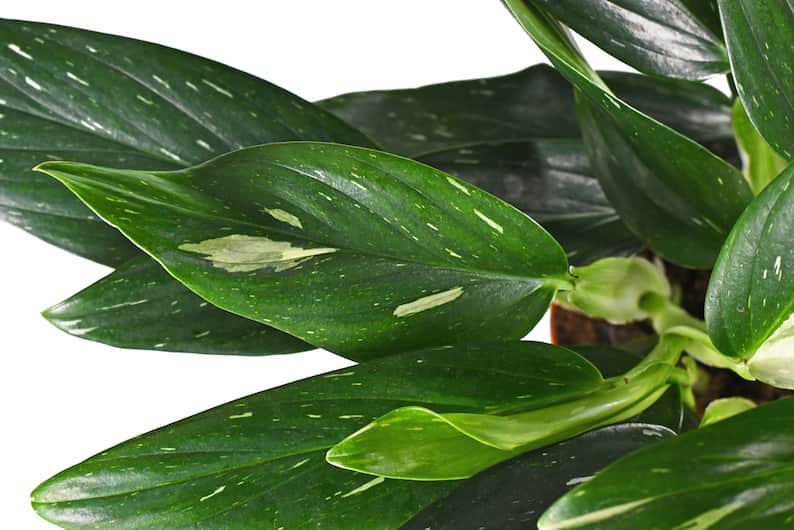
Table of Contents
How do you care for Monstera Standleyana?
Monstera Standleyana care entails ensuring sufficient water, light, and nutrients, as well as good-quality soil and plenty of humidity. While the Standleyana is low-maintenance and has straightforward care requirements, occasional fertilizing is beneficial. Standleyana does best indoors but can be grown outside with proper care and shelter.
Hailing from various regions of South America, including Costa Rica, Honduras, and Panama, this climbing epiphyte is better suited to warmer climates, much like other varieties of Monstera. Still, it can fare exceptionally well in indoor environments, making it a great choice of houseplant.
The reason for this is that indoor environments are easy to regulate. It is not so much that one needs to fuss over a Monstera Standleyana, but rather just to be consistent. They aren’t prone to pests or diseases, so as a Monstera parent, all you need is to make sure its needs are met in terms of water, light, soil, humidity, and feeding.
In what follows, we’ll look at each of these factors in slightly greater detail.
What soil should I use for Monstera Standleyana?
For Monstera Standleyana, good soil is a good foundation for growth. This plant requires a well-draining, aroid soil mix that you can either purchase pre-blended from a garden center or nursery or mix yourself. Key ingredients to look out for include bark for aeration, perlite for moisture-retention, and sphagnum moss for nutrients.
As Monstera enjoy a pH level of 5.5 to 7, a bit of activated charcoal can help you to achieve a neutral reading. As a base, always select a high-quality potting soil for your Monstera that’s formulated for indoor plants.
Best soil for Monsteras
Specially designed soil for your Monstera. Light and well-draining, making it perfect for avoiding root rot, while being packed with just the right nutrients to keep your plant happy.
When should I water Monstera Standleyana?
Reports differ on how often one should water a Monstera Standleyana, but in my experience, the best method is to gauge when it’s thirsty rather than sticking to a regimented routine. Generally, you’ll be looking at watering every 7 to 10 days in a typical indoor environment, but this can vary, temperature-dependent.
Instead, look to water a Monstera Standleyana when the top inch of its soil has completely dried. While hardy, Monstera can be prone to root rot, so it’s always best to err on the side of less frequent watering to prevent waterlogged soil.
When you do hydrate your plant, give it a hearty dose, but don’t let water pool in its drip tray, as this fast becomes a breeding ground for bacteria.
How much light does Monstera Standleyana need?
Monstera love warmth and seek light, so the Standleyana needs to be situated close to East- or South-facing windows, set a few feet back to avoid direct exposure. Morning light is better than harsh afternoon rays, but they should have access to bright, indirect light for at least six hours each day.
Tropical epiphytes like the Monstera Standleyana grow in the underbrush of rain and cloud forests. Using larger trees for support, Monstera attach their aerial roots to their trunks and climb upwards toward the sun breaking through the canopy above them.
Ergo, in their natural habitat, they are accustomed to dappled light. Fortunately, as outlined above, this is easy to emulate in a home environment allowing you to meet your Monstera’s light requirements with careful placement.
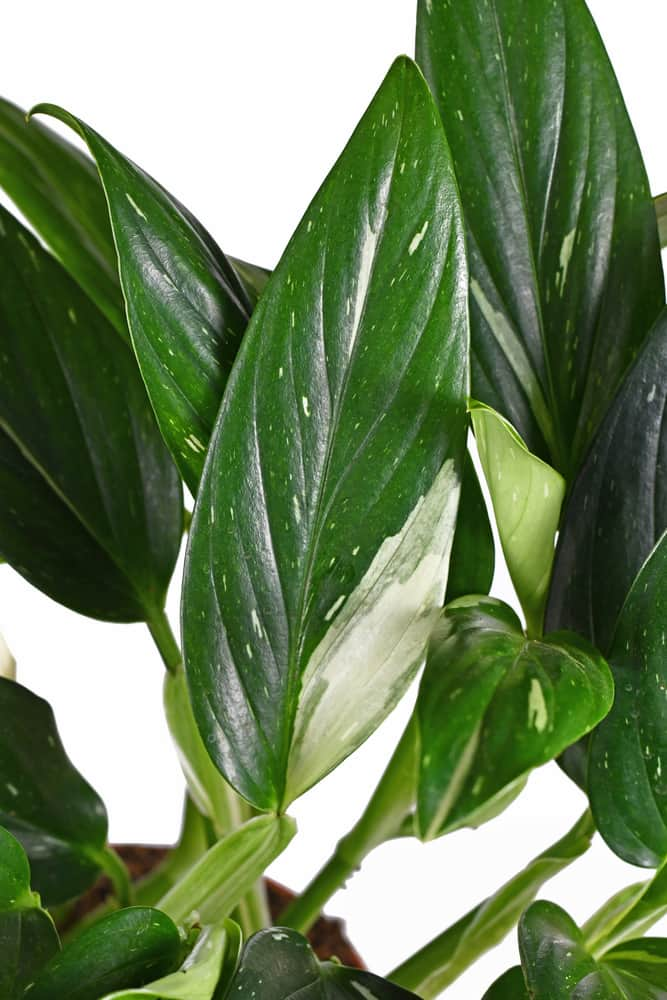
Should I fertilize my Monstera Standleyana?
There are no hard and fast rules about feeding Monstera Standleyana, but they can only benefit from it. Like all houseplants, these beauties do well with a bit of an added boost of nutrients, especially in their fast-growing months in spring and summer.
A slow-release, all-purpose, balanced liquid fertilizer for your Monstera will do the trick – like the one below!
Best fertilizer for Monsteras
Jack’s Classic 20-20-20 All Purpose Fertilizer
A great fertilizer with the perfect balance for your Monstera. Simply dissolve in water and feed your plant to watch it thrive.
Use slightly less than instructed initially to make sure it has no detrimental effects, but once it has adapted, adopt a feeding regime of two to three doses per year. This will keep your Monstera extra happy and healthy and provide it with added energy for renewed growth.
Do Monstera Standleyana need a lot of humidity?
To best emulate a Standleyana’s natural environment, you should try to provide them with as much humidity as possible. It is in warm, moist environments that these plants truly thrive. Unfortunately, most homes aren’t naturally as humid as Monstera would like, but this can be easily supplemented.
Any one of the following ways will do the trick and help you get the humidity your Monstera needs.
Firstly, you may want to consider investing in a plug-in humidifier. This is beneficial for plants and humans alike. If that’s not to your taste, explore setting your Monstera over a damp pebble tray, which will evaporate moisture over time.
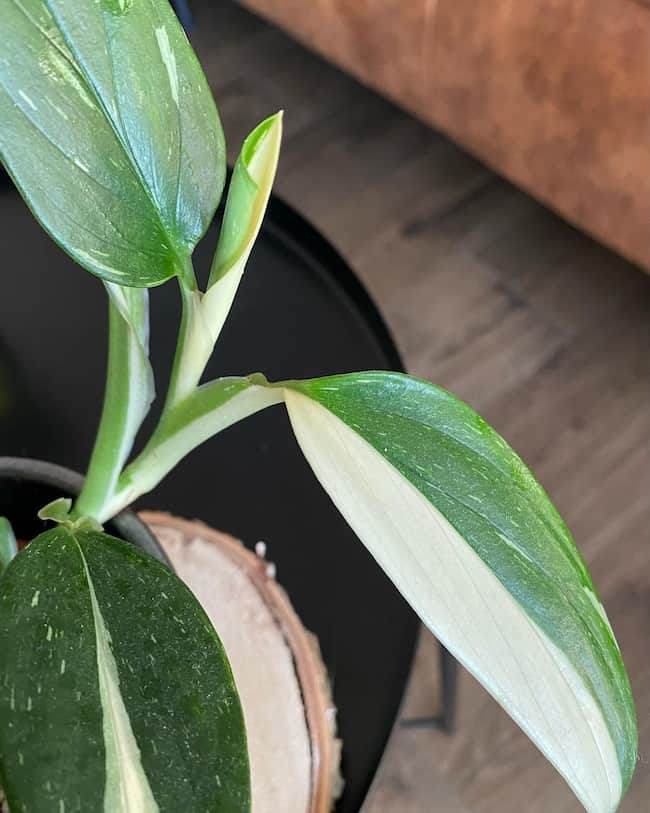
Still not? No problem. Simply mist your Standleyana’s leaves once per week with a spray bottle, treating them with extra moisture and keeping them thriving and green.
Monstera won’t grow as fast as usual in cooler, less humid environments, but it is also not a death sentence. They are well-adjusted and can survive in a variety of conditions and temperatures.
Are all Monstera Standleyana variegated?
All Monstera Standleyana are variegated and present with speckles or dashes or white, cream, or yellow across their leaves and stems, to varying degrees. This unique presentation is striking against Standleyana’s leaves’ dark green base color.
In the plant world, variegation is the phenomenon where leaves have more than one color, usually as a result of genetic tissue mutation. When it comes to Monstera specifically, light-colored variegation is exceptionally rare, except in special cases like the Monstera Standleyana Albo variegata.
For this reason, this beautiful plant is often misidentified as a Philodendron, which is a family of plants known for their variegation. In fact, I often see Monstera Standleyana labeled as Philodendron cobra, which is an entirely different species that just happens to be similar in appearance.
To identify a Monstera Standleyana vs Philodendron cobra, irrespective of its often-misleading variegation, look at its growth pattern and leaf shape. The ovate leaves of this plant usually reach lengths of about 5 to 10 inches (12 to 25 centimeters), and they grow upwards in an alternate but upright pattern. Aerial roots and nodes are located every few inches along their stems, and when left to grow freely, they can become up to 20 feet tall (6 meters).
What colors do the variegated leaves on the Monstera Standleyana turn?
Variegation on a Monstera Standleyana is either white, cream, or yellow. The white varieties are most common and usually display specks or splatters or white across their leaves. Yellow variegation is slightly rarer and ranges from off-yellow to deep cream.
In both cases, it is the size and spread of the variegation that makes individual plants sought-after. Speckles and dashes are standard, but some Standleyana may have large portions of discoloration, which make them very desirable for collectors.
What is Monstera Standleyana Albo?
Monstera Standleyana Albo variegata refers to a distinctly variegated species of Standleyana with prominent white splashes or bands across its leaves. While all Standleyana are variegated, this version is more so than the standard species that is commonly and freely available.
As mentioned in the previous section, variegation is part and parcel of the Standleyana, but it is when entire areas of their leaves are white or cream that these plants take on a whole new feel, becoming truly exquisite to behold.
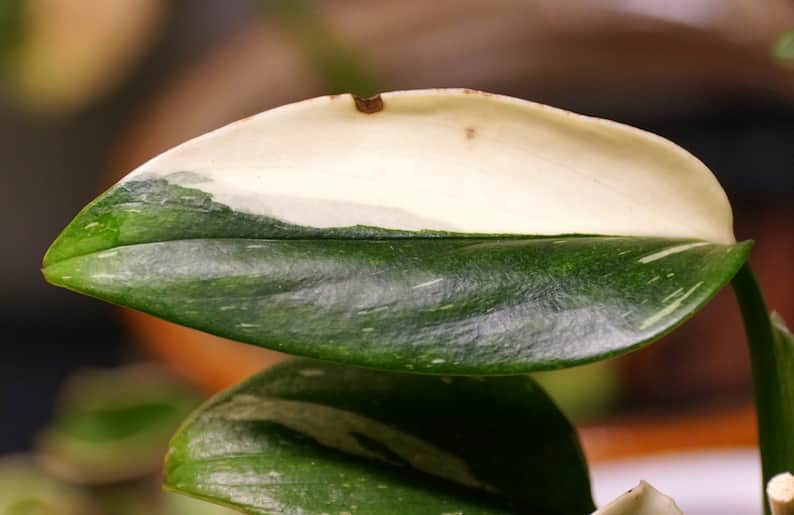
Cultivars with this patterning are called Standleyana Albo, and they are harder to find and more expensive than their counterparts. Albo also have marginally different care requirements, as they need more sun to make up for their lack of pigmentation.
You see, the white sections of a Standleyana Albo’s leaves are completely devoid of chlorophyll, which is what plants use to convert sun energy. This means the rest of the cells of a Standleyana need to work extra hard to keep it growing and healthy.
While not extremely common, the Standleyana Albo can be propagated and generally carry over their signature patterning to their offshoots.
Is Monstera Standleyana an Aroid?
The Monstera Standleyana is an Aroid, meaning it derives from the family Araceae. Like most Aroid plants, Standleyana are favored for their foliage above their flowers (which are hardly ever seen in an indoor setting in any case). Irrespective, the shape and make-up of their flowers are responsible for their classification.
Aroid flowers consist of two parts: a spathe and a spadix. The distinctly-shaped spathe looks suspiciously like one giant petal but is, in fact, a bract. On the other hand, the spadix looks like a spike or rod covered in minuscule flowers and serves to attract pollinators.
How do you propagate Standleyana?
The easiest way to propagate Monstera Standleyana is through stem cuttings, either in water or directly into prepared soil. In the right conditions, cuttings from a healthy plant can root within 4 to 6 weeks, ready to be planted and grown to maturity.
One thing most Monstera have in common is that they are gratifying propagators. The process to root a Monstera Standleyana is simple, provided your cutting is healthy and has one or two nodes from which new growth can spring.
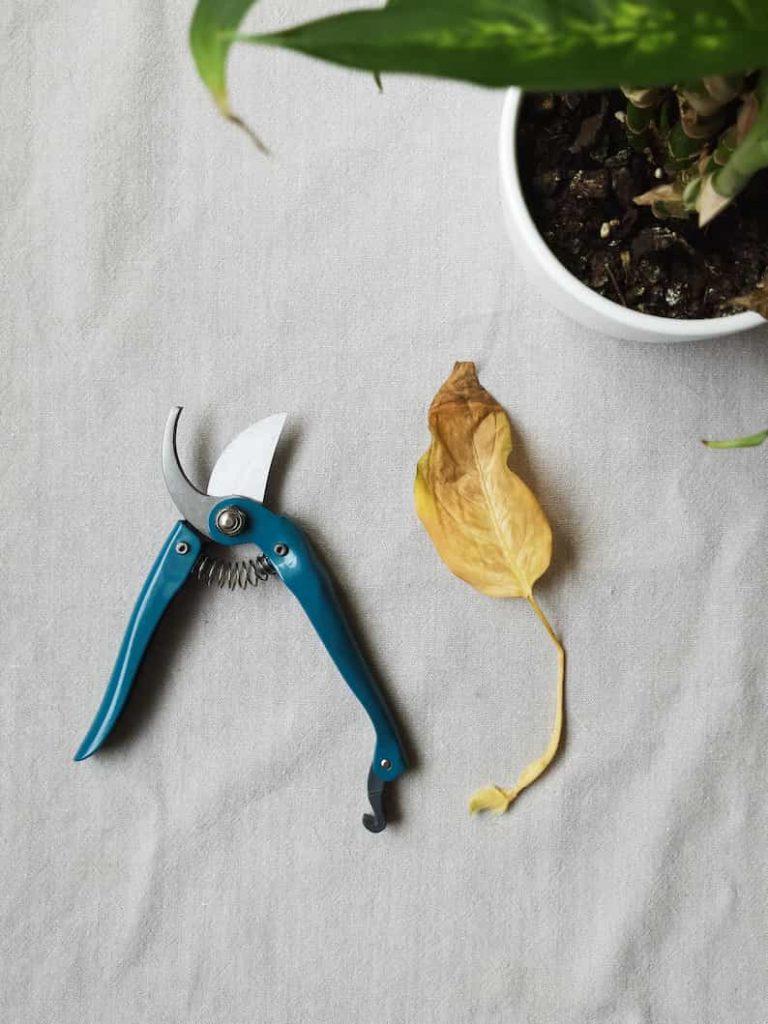
Before I get into how to propagate Monstera cuttings, there are a few things to consider when selecting stems from your existing plant. The first is to make sure you always use clean, sharp, sterilized tools to prevent the potential spread of diseases to your Monstera. The second is to make sure your plant is healthy. A Monstera in distress will not be served by having a portion of its stem lopped off.
Finally, make sure your growing medium (be it water or soil) is ready for when you make your cut. You do not want to expose your cutting to air for longer than necessary, so make sure to plan and set up your workstation in advance.
Only propagate Monstera in spring and summer. In winter, these beauties reach a state of semi-dormancy and won’t appreciate having to recoup the energy they lose to a cutting.
Propagating a Monstera Standleyana in water
This is the easiest and most sure-fire way to propagate a stem cutting from a Monstera Standleyana. All you need to do is select your cutting, check to see that it has two to three healthy nodes and one or two leaves, and pop it into a jar of fresh water. For added measure, you can dip the cut end of the stem in growth hormone first.
Set the jar close to a sunny window, and make sure to refresh the water once a week to keep it oxygenated. With luck, you’ll see new growth in roughly four weeks. Once it has roots that are 1 – 2 inches (2 – 5 centimeters) in length, transfer your cutting into a planter with soil.
Find out more: 6 Easy Steps to Grow a Monstera in Water
Propagating a Monstera Standleyana in soil
While advisable, it’s not necessary to root a Monstera Standleyana in water first, as they can be grown directly in soil too. Start by preparing your pot with a good-quality Aroid soil mix, and then place your cutting one-third of the way inside it (after dipping it in rooting hormone if you have some on-hand). If necessary, stake the cutting to offer it support.
With this method, the important thing is to make sure your cutting has plenty of moisture and humidity. Standleyana can’t draw water from the soil without roots, so they rely on getting it from their environments. You can either mist your cutting daily or cover it with plastic to trap in dampness and humidity. As with water propagation, keep your juvenile plant close to bright, indirect light.
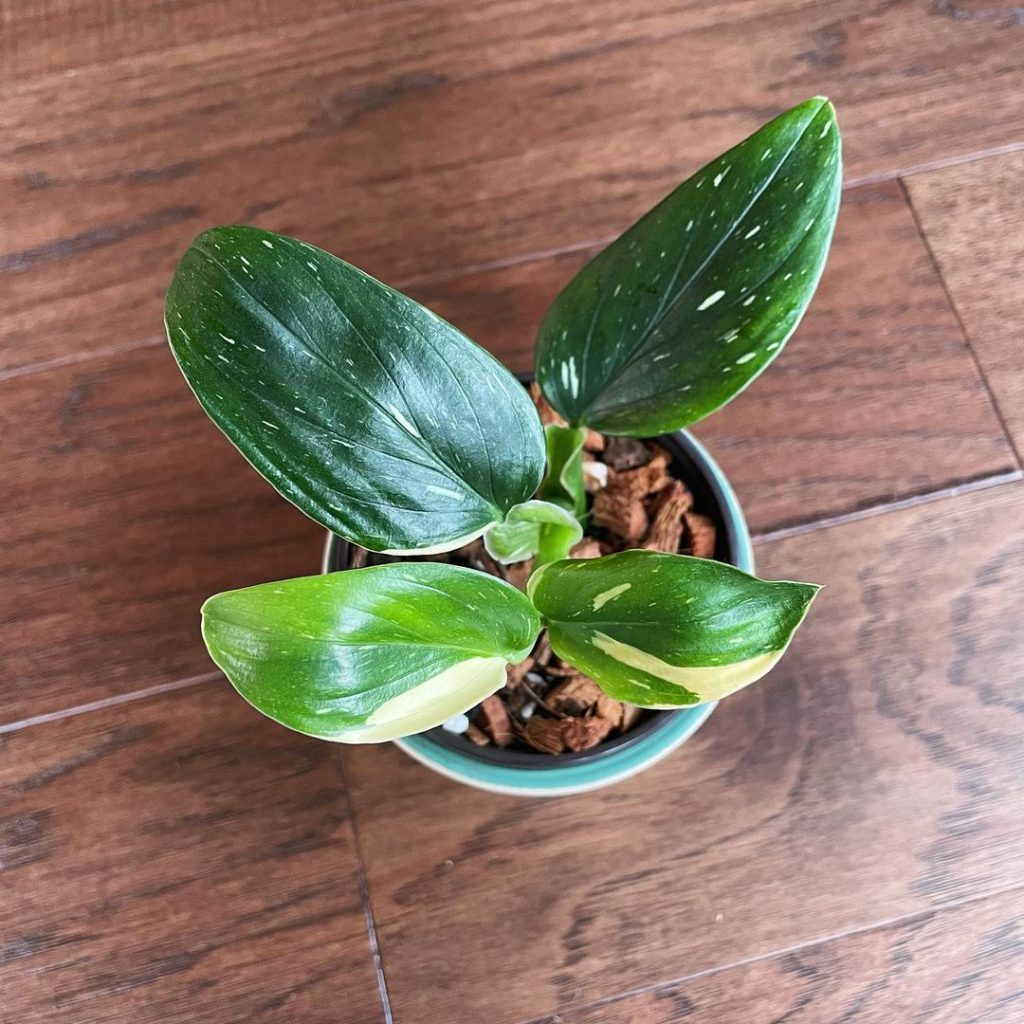
Growing Monstera Standleyana seeds
It is possible to grow Monstera Standleyana from seed, but trickier than propagating. Monstera seeds have a relatively short shelf-life and aren’t always guaranteed to germinate.
To give your seeds their best chance, soak them in lukewarm water for 12 hours before planting. Once in soil, keep them as warm as possible. They should start to grow within 4 to 6 weeks.
Once they have become saplings, keep them moisturized by spritzing them with water and covering them lightly with a plastic cover or dome to trap humidity.
Is Monstera Standleyana rare?
Monstera Standleyana is relatively rare compared to other members of the Monstera family, although this is slowly changing as Monstera overall become more popular. Further complicating the issue of availability is the fact that the Standleyana is often mislabeled as a Philodendron.
As a general rule of thumb, the more exotic a Monstera is, the harder it is to find. Common varieties like the Deliciosa and adansonii can usually be tracked down in local garden centers, but for specific cultivars like the Standleyana, you would need to default to a breeder or online supplier – or a lovely friend willing to give you a cutting.
So, while it’s not nearly as rare as the Monstera Obliqua, you’re unlikely to come across a Standleyana by accident. Instead, you would need to set out to find one to add to your collection, or you could strike gold and come across one by accident, which has been known to happen.
Very variegated Monstera types, like the Standleyana Albo, are even more scarce because they are snapped up quickly thanks to their beautiful patterning. Generally, these are sold as cuttings or propagated juveniles through specialist breeders.
Is Monstera Standleyana a fast grower?
Monstera Standleyana is fast-growing in ideal environments, especially during the spring and summer. It is a smaller type of Monstera, but what it lacks in stature, it makes up for in spread, growing upwards in an alternating pattern that gives it a full, dense aesthetic.
It seems obvious to say that a plant grows well in ideal conditions, but it couldn’t be more accurate than for this species of Monstera. With lots of humidity, water, and light, a Standleyana can grow so fast that it requires repotting a minimum of once per year.
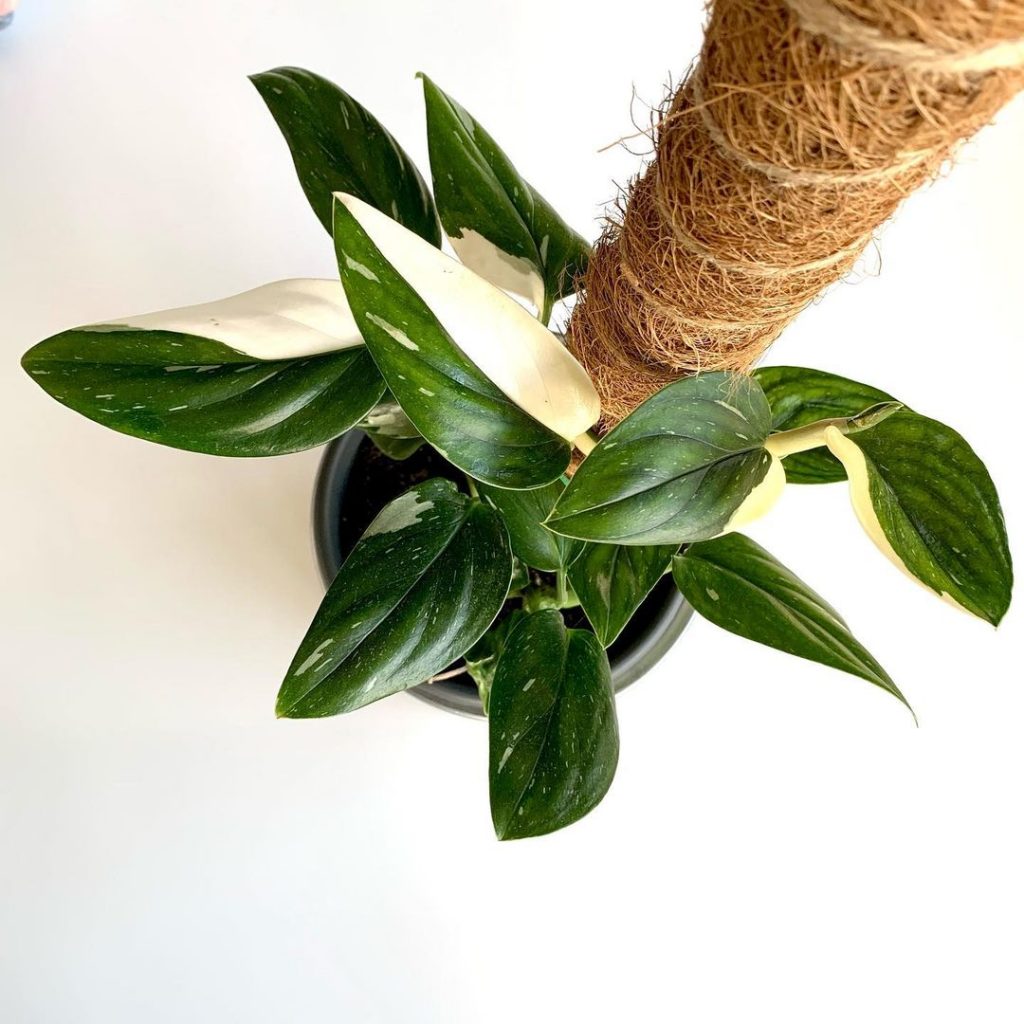
As a smaller species of Monstera, this beauty almost seems to overcompensate with its lush foliage, which grows densely. Its smaller leaves also reach full size at a much faster rate than other Monstera. If it has a good spot to climb (like if you add a nutrient-rich moss pole for your Monstera), it will be inspired to expand even more rapidly.
But should you notice your Standleyana isn’t gaining size quite as fast as you’d like, don’t panic. It may mean it isn’t receiving as much light or humidity as it would like. This doesn’t mean it’s in poor health, but just that it may need to be moved to a spot that better suits its needs.
Why are my Monstera Standleyana leaves curling?
Curling is never a good sign when it comes to Monstera Standleyana. Usually, it indicates either a deficiency or an oversupply of water, fertilizer, or light. Should you notice curling, try to identify the cause of the problem as a matter of urgency so you can treat your plant accordingly.
If you notice browning, wilting, curling, or yellowing leaves on your Monstera, this usually occurs when plants are trying to communicate distress. Generally, it’s related to water issues – either underwatering or overwatering your Monstera, which unfortunately have the same side effects. To determine the cause, test the soil with your fingertip. If it is heavy and soggy, your plant may be in the beginning stages of root rot. If it is extremely dry, your Standleyana’s leaves may be curling from dehydration.
If water is not the problem, your Monstera Standleyana may be undergoing stress caused by a lack of nutrients in its soil, which can be solved with repotting or fertilization. Conversely, it may be overfertilized, which causes chemical burn and, by default, yellowing and curling.
Think that repotting could solve the problem? Check out When to Repot a Monstera to Keep Your Plant Happy
An extreme lack of light may also be the reason for Monstera Standleyana’s ill health, although the over- or under-exposure to sun would need to be very severe for this to happen. Leaves may start to curl from prolonged periods in direct sunlight, which gives your Monstera sunburn.
If none of the above seem to be the issue, check your Monstera Standleyana for pests or other signs of disease. Although less common, intense pest infestations can cause Monstera leaf curl and leaf drop and must be dealt with immediately.
Does Monstera Standleyana have fenestrations?
While most members of the Monstera family develop fenestrations as they mature, the Monstera Standleyana is an exception, and its leaves remain whole for the duration of its life. Some say it may fenestrate in its natural habitat, but apertures will not occur in home environments.
When we think of Monstera, we usually associate them with the big jungle leaves we see on art prints and home décor the world over, distinguishable by their distinct fenestrations. And granted, almost all Monstera have windowed leaves, which is why they’re so easy to recognize as a species.
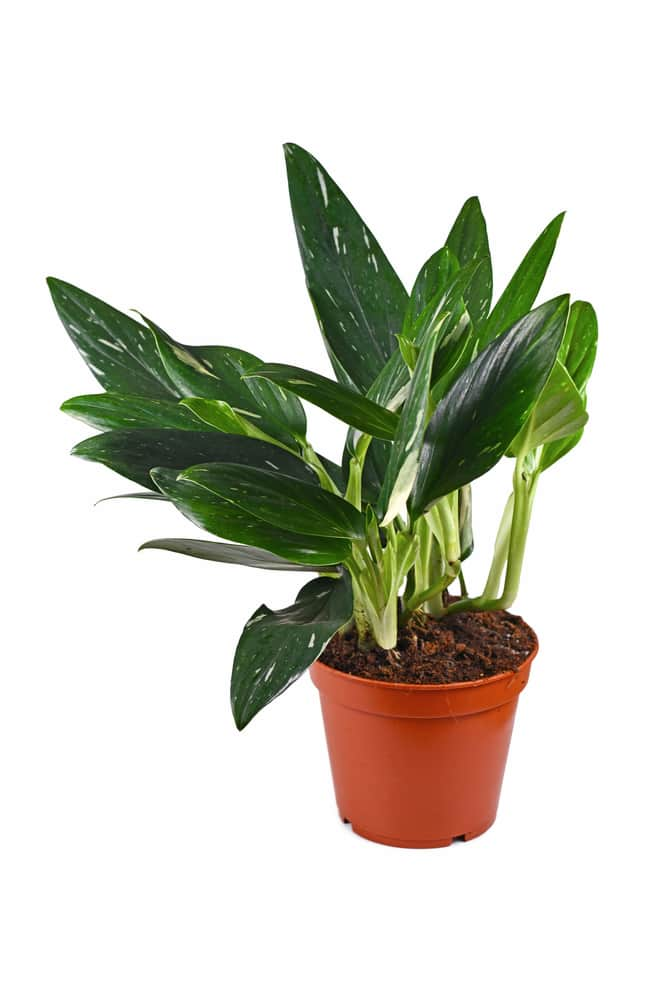
The Monstera Standleyana is slightly different in this regard and shows no evidence of developing any holes, even when it becomes large in size. This may be the reason it is often confused for a Philodendron or simply not known as a Monstera at all.
Next time you’re on the hunt for a unique Monstera, look for this beauty’s variegation instead. While this Monstera may never have split leaves, it will reward you with its undeniable good looks and, like all Monstera, its incredible ease of care.
Can a Monstera Standleyana live in water?
Monstera Standleyana can live and root in water for a few weeks or months but should ideally be transferred into a planter with soil once they have grown significant root systems. Soil contains rich nutrients and minerals that water alone does not and that Standleyana needs to thrive.
There is something beautiful about watching a Monstera Standleyana grow roots, especially when you can monitor it through glass and water. However, this is only really suitable for your plant during its rooting phase, as it will need extra food from soil once it starts to grow in earnest.
That being said, it’s not to say that your Monstera Standleyana will die if left in water. It can likely survive for months or even years (provided the water is frequently replaced). However, it is unlikely to thrive and more likely to develop diseases or distress. In water, they also tend to grow more slowly.
Is the Monstera Standleyana toxic?
All Monstera are toxic to varying degrees, as they contain a sticky sap in their leaves and stems that is mildly poisonous to humans and animals, depending on consumption. Contact with skin can cause irritation and rashes, and ingestion can cause gastrointestinal distress or difficulty breathing.
The good news is that Monstera Standleyana is hardly tasty, so it’s unlikely to be a choice snack for either pets or children. Of course, accidents and curiosity happen, so should you suspect a human or animal has ingested or had contact with Standleyana sap, help them with medical attention.
Find out more about what to do if you think your pet has chewed on this plant from our article: Is Monstera Toxic to Cats?
Generally speaking, the damage caused by this plant should be minimal, resulting in a bit of stomach upset, nausea, or skin irritation, but it’s always best to err on the side of caution and seek advice from a professional. Extreme reactions can result in pulmonary distress, although this is incredibly rare.
Prevention is better than cure, though, so keep your precious Standleyana out of reach of children and animals. When handling this plant, work with gloves, and prevent breakage of its leaves and stems where possible.
How much is a Monstera Standleyana Albo?
A Monstera Standleyana Albo can fetch between $50 and $180 depending on its size, variegation, and breeder. As these plants are pretty rare, they don’t show up on the market all that often and thus can vary significantly in price from vendor to vendor.
There is no art to determining Monstera Standleyana Albo’s price, and ultimately it depends on availability and demand, as well as on size and aesthetic. The more distinct a Standleyana’s variegation, the higher the price you’ll pay. In fact, be prepared for some sticker shock when you see some variegated Monstera prices.
A Monstera Standleyana cutting, on the one hand, may go for under $100, as there is no guarantee it will root with its new owner. On the other hand, a full-grown variegated Monstera Standleyana’s price may shoot way higher if it is a large, healthy specimen.


